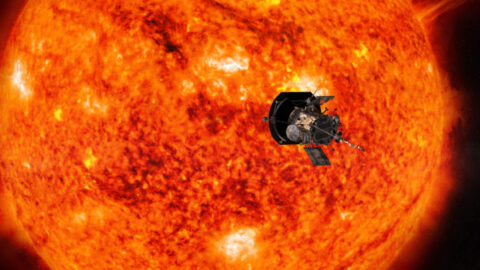There’s a space joke so old you’re unlikely to find its provenance on the internet: If you want to visit the sun, go at night.
If you’re scratching your head about the punchline, that’s because the sun, our solar system’s star that provides heat and light, is a blindingly bright, radiating orb — even after sunset, when Earth’s daily rotation makes it disappear below the horizon.
It goes without saying that the sun is hot, but actual temperatures at the sun might surprise you.
How hot is the sun?
The hottest part of the sun is in its core, where the temperature can rise to an unfathomable 27 million degrees Fahrenheit (or 15 million degrees Celsius), according to NASA. Meanwhile, the sun’s surface is a comparatively cooler 10,000 degrees Fahrenheit (or 5,500 degrees Celsius).
Of course, 10,000 degrees Fahrenheit is still scorching hot — five times hotter than the glowing, red-orange lava belching from volcanoes on Earth. The temperature of the sun’s surface is one NASA administrator Bill Nelson often references when comparing the heat a spaceship encounters as it’s re-entering Earth’s atmosphere.
“Orion will come home faster and hotter than any spacecraft has before,” NASA Administrator Bill Nelson told reporters in August 2022 before the Artemis I spaceflight. “It’s going to hit the Earth’s atmosphere at 32 times the speed of sound, it’s going to dip into the atmosphere, and bleed off some of that speed, before it starts descending through the atmosphere.”
When the uncrewed Orion spaceship came home from its maiden voyage in December 2022, it traveled 24,500 mph in 5,000 degrees Fahrenheit — half the temperature of the sun’s surface, Nelson said. That singed the ship’s protective heat shield, something engineers are investigating and possibly changing before the next Artemis mission, which will carry astronauts around the moon.
But one of the most confusing things about the sun’s temperature is that its corona, its outermost atmosphere, is much hotter, and it only gets hotter the farther it stretches from the surface. Scientists estimate that the corona reaches up to 3.5 million degrees Fahrenheit (or 2 million degrees Celsius).
Scientists call this mystery the “coronal heating problem.”
What is the ‘coronal heating problem?’

Astronomers have discovered ‘shooting stars’ on the sun’s surface.
Credit: Patrick Antolin / ESA / Solar Orbiter / EUI / HRI
Want more science and tech news delivered straight to your inbox? Sign up for Mashable’s Light Speed newsletter today.
“The corona, the sun’s outer atmosphere, is several-hundred times hotter [than the surface],” according to a NASA explanatory video below. “That’s the opposite of what happens with a fire when it gets cooler the farther away you get.”
But scientists are trying to answer that question with the Parker Solar Probe mission. The spacecraft has been flying through the corona, gathering data for scientists to study its behavior. The probe completed its 17th close approach to the sun on Sept. 27, breaking its distance record by coming within 4.5 million miles from the surface.
Building instruments for the probe that could withstand the scorching heat without disintegrating — and continue taking measurements — was an engineering feat. The Solar Probe Cup, equipment designed by scientists at the Harvard-Smithsonian Center for Astrophysics in Cambridge, Massachusetts, sits outside the probe’s heat shield and catches some of the sun’s plasma.
Though the cup glows like a fireplace poker as it swoops through the corona, it never reaches the millions of degrees of its environment.
To understand how that’s possible its first important to distinguish the difference between temperature and heat: Temperature measures how fast particles are moving, while heat is the amount of energy they transfer.

NASA’s Parker Solar Probe has been flying through the corona, gathering data for scientists to study its behavior.
Credit: NASA / Johns Hopkins APL / Steve Gribben
A 100-degree day, for example, feels hot on people’s skin because lots of molecules in the air are quickly hitting their bodies, transferring heat, Anthony Case, the center’s instrument scientist, explained to Mashable in 2021.
“You can feel how hot, how fast they’re moving. That’s how we sense temperature,” he said.
But in the vastness of space, there are very few particles, so there are fewer particles around to transfer energy — and, thus, heat.
“So even though it (could be) a million degrees, there’s billions of times, or probably billions of billions of times, less particles than there are in the air on Earth,” he said.
Topics
NASA
